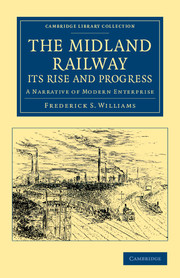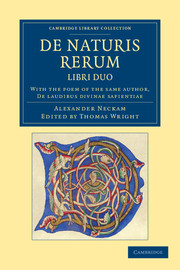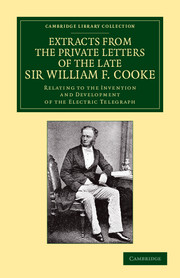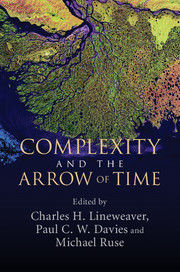Refine search
Actions for selected content:
13588 results in History of science and technology
9 - Emergent order in processes: the interplay of complexity, robustness, correlation, and hierarchy in the biosphere
- from Part III - Biological complexity, evolution, and information
-
-
- Book:
- Complexity and the Arrow of Time
- Published online:
- 05 July 2013
- Print publication:
- 08 August 2013, pp 191-223
-
- Chapter
- Export citation
6 - Emergent spatiotemporal complexity in field theory
- from Part II - Cosmological and physical perspectives
-
-
- Book:
- Complexity and the Arrow of Time
- Published online:
- 05 July 2013
- Print publication:
- 08 August 2013, pp 113-132
-
- Chapter
- Export citation

The Midland Railway: Its Rise and Progress
- A Narrative of Modern Enterprise
-
- Published online:
- 05 August 2013
- Print publication:
- 26 April 2012
- First published in:
- 1876

De naturis rerum, libri duo
- With the Poem of the Same Author, De laudibus divinae sapientiae
-
- Published online:
- 05 August 2013
- Print publication:
- 15 November 2012
- First published in:
- 1863

Extracts from the Private Letters of the Late Sir W. F. Cooke
- Relating to the Invention and Development of the Electric Telegraph
-
- Published online:
- 05 August 2013
- Print publication:
- 21 March 2013
- First published in:
- 1895
Writing, printing, speaking: Rhesus blood-group genetics and nomenclatures in the mid-twentieth century
-
- Journal:
- The British Journal for the History of Science / Volume 47 / Issue 2 / June 2014
- Published online by Cambridge University Press:
- 02 August 2013, pp. 335-361
- Print publication:
- June 2014
-
- Article
-
- You have access
- Open access
- HTML
- Export citation
Onwards facing backwards: the rhetoric of science in nineteenth-century Greece
-
- Journal:
- The British Journal for the History of Science / Volume 47 / Issue 2 / June 2014
- Published online by Cambridge University Press:
- 01 August 2013, pp. 217-237
- Print publication:
- June 2014
-
- Article
- Export citation
William Harvey, Aristotle and astrology
-
- Journal:
- The British Journal for the History of Science / Volume 47 / Issue 2 / June 2014
- Published online by Cambridge University Press:
- 01 August 2013, pp. 199-215
- Print publication:
- June 2014
-
- Article
- Export citation
SIC volume 26 issue 3 Cover and Back matter
-
- Journal:
- Science in Context / Volume 26 / Issue 3 / September 2013
- Published online by Cambridge University Press:
- 25 July 2013, pp. b1-b10
- Print publication:
- September 2013
-
- Article
-
- You have access
- Export citation
Popular Science and Politics in Interwar France
-
- Journal:
- Science in Context / Volume 26 / Issue 3 / September 2013
- Published online by Cambridge University Press:
- 25 July 2013, pp. 459-471
- Print publication:
- September 2013
-
- Article
- Export citation
Popular Science Magazines in Interwar Britain: Authors and Readerships
-
- Journal:
- Science in Context / Volume 26 / Issue 3 / September 2013
- Published online by Cambridge University Press:
- 25 July 2013, pp. 437-457
- Print publication:
- September 2013
-
- Article
- Export citation
The Power of Weak Competitors: Women Scholars, “Popular Science,” and the Building of a Scientific Community in Italy, 1860s-1930s
-
- Journal:
- Science in Context / Volume 26 / Issue 3 / September 2013
- Published online by Cambridge University Press:
- 25 July 2013, pp. 405-436
- Print publication:
- September 2013
-
- Article
- Export citation
Popular Science as Cultural Dispositif: On the German Way of Science Communication in the Twentieth Century
-
- Journal:
- Science in Context / Volume 26 / Issue 3 / September 2013
- Published online by Cambridge University Press:
- 25 July 2013, pp. 473-508
- Print publication:
- September 2013
-
- Article
- Export citation
From Papers to Newspapers: Miguel Masriera (1901–1981) and the Role of Science Popularization under the Franco Regime
-
- Journal:
- Science in Context / Volume 26 / Issue 3 / September 2013
- Published online by Cambridge University Press:
- 25 July 2013, pp. 527-549
- Print publication:
- September 2013
-
- Article
- Export citation
An Evolving Scientific Public Sphere: State Science Enlightenment, Communicative Discourse, and Public Culture from Imperial Russia to Khrushchev's Soviet Times
-
- Journal:
- Science in Context / Volume 26 / Issue 3 / September 2013
- Published online by Cambridge University Press:
- 25 July 2013, pp. 509-526
- Print publication:
- September 2013
-
- Article
- Export citation
Introduction: Communicating Science: National Approaches in Twentieth-Century Europe
-
- Journal:
- Science in Context / Volume 26 / Issue 3 / September 2013
- Published online by Cambridge University Press:
- 25 July 2013, pp. 393-404
- Print publication:
- September 2013
-
- Article
- Export citation
SIC volume 26 issue 3 Cover and Front matter
-
- Journal:
- Science in Context / Volume 26 / Issue 3 / September 2013
- Published online by Cambridge University Press:
- 25 July 2013, pp. f1-f3
- Print publication:
- September 2013
-
- Article
-
- You have access
- Export citation
‘Keeping in the race’: physics, publication speed and national publishing strategies in Nature, 1895–1939
-
- Journal:
- The British Journal for the History of Science / Volume 47 / Issue 2 / June 2014
- Published online by Cambridge University Press:
- 11 July 2013, pp. 257-279
- Print publication:
- June 2014
-
- Article
- Export citation
Gate-keeping and localizing in scientific translation publishing: the case of Richard Taylor and Scientific Memoirs
-
- Journal:
- The British Journal for the History of Science / Volume 47 / Issue 3 / September 2014
- Published online by Cambridge University Press:
- 11 July 2013, pp. 433-450
- Print publication:
- September 2014
-
- Article
- Export citation

Complexity and the Arrow of Time
-
- Published online:
- 05 July 2013
- Print publication:
- 08 August 2013
